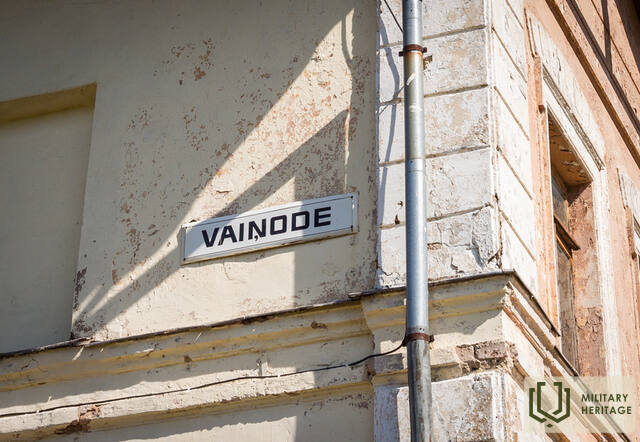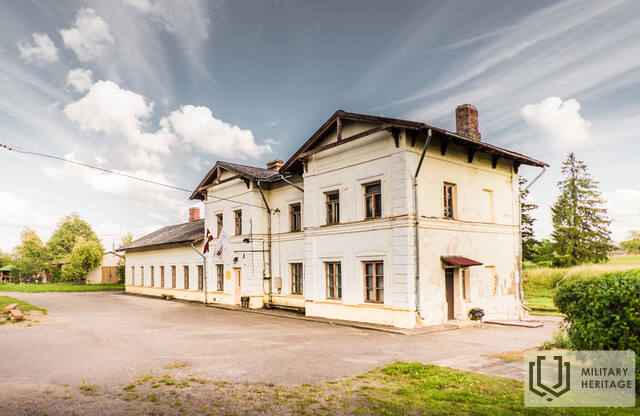Vainodės stotis Infrastruktūra

Geležinkelio stoties pastatas buvo atidarytas kartu su Liepojos–Vainodės geležinkelio linijos statyba 1871 m. Pats stoties pastatas buvo atidarytas 1872 m. Tai taip pat buvo didelės veiklos, plėtojant Vainodės centrines gatves, pradžia. Reikšminga tai, kad to meto vadovuose kiekvieno pastato ar objekto atstumas buvo nurodomas kaip atstumas nuo geležinkelio stoties. Geležinkelio stotis kadaise buvo svarbus karinis transporto mazgas.
Pirmojo pasaulinio karo metu nuo stoties iki aerodromo buvo nutiesta atšaka, kuria buvo atgabenamos medžiagos (metalinės formos angarams), kranai, gervės ir amunicija karo atsargoms, kurios vėliau cepelinais buvo gabenamos į Rygą ir bombarduojamos rusų įtvirtinimai.
Geležinkelio stoties pastatas nebuvo nuniokotas Antrojo pasaulinio karo ir laikui bėgant nepakito savo išvaizdos. Vainodės stotį galima pamatyti iš išorės.
Karinė veikla Vainodės apylinkėse siejama su sėkmingu Raudonosios armijos puolimu, prasidėjusiu 1944 m. spalio 5 d. Šiaulių apylinkėse. Greitai sutriuškinę silpną vokiečių pasipriešinimą, sovietų tankų daliniams buvo pavesta užimti strategiškai svarbią Liepojos–Šaulio geležinkelio liniją. 1944 m. spalio 9 d. ankstyvą rytą puolimą pradėjo pirmieji 19-ojo tankų korpuso 79-osios tankų brigados daliniai ir atskiri 143-osios tankų brigados daliniai. Žlugus vokiečių frontui, rytiniame Vainodės pakraštyje buvo tik nedideli vokiečių 61-osios pėstininkų divizijos daliniai, remiami šarvuočių. Pasipriešinimas buvo greitai įveiktas ir spalio 9 d. vakare visą Vainodę visiškai kontroliavo Raudonoji armija. Spalio 10 d. atvyko sovietų 6-osios gvardijos armijos 103-ojo šaulių korpuso daliniai ir tęsė atakas, atstumdami vokiečių 61-ąją pėstininkų diviziją 2 km į šiaurę nuo Skaistkalnės sanatorijos. Sovietų pajėgoms užimant Vainodę be didelių kovų, Vainodės stotis ir miesto pastatai nukentėjo palyginti mažai.
1944 m. spalio 24 d. kovos šiek tiek priartėjo prie Vainodės, kai vokiečių 10-asis korpusas, vadovaujamas 14-osios tankų divizijos, įvykdė puolimo operaciją, pravarde „Eberhardas“. Kovų metu fronto linija sutelkė jėgas į šiaurę nuo sanatorijos ir ten išsilaikė iki spalio 27 d., kai Raudonoji armija pradėjo puolimą, vadinamą 1-uoju Kurlando bolševiku.
Panaudoti šaltiniai ir literatūra:
Vaiņodės stoties pastatas – Leišmalīte (leismalite.lv)
Susijusi laiko juosta
Susijusios temos
Susijusi istorija
Paskutinis Vokietijos armijos 3-iojo šarvuoto traukinio mūšis Vainodės stotyje
1944 m. spalį vokiečių armija traukiasi. Trečiasis šarvuotasis traukinys atvyksta į Vainodės stotį.
Žlugus vokiečių frontui, rytiniuose Vainodės pakraščiuose buvo tik nedideli vokiečių 61-osios pėstininkų divizijos daliniai, remiami šarvuoto traukinio. Pasipriešinimas buvo greitai įveiktas ir spalio 9 d. vakare visą Vainodę visiškai kontroliavo Raudonoji armija.
Vokietijos armijos šarvuoto traukinio Nr. 3 vado ataskaita atspindi įtemptus tų dienų įvykius ir šarvuoto traukinio Nr. 3 praradimą.
















